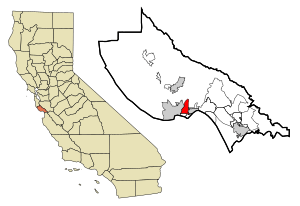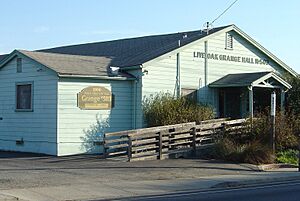Live Oak, Santa Cruz County, California facts for kids
Quick facts for kids
Live Oak
|
|
|---|---|

Location in Santa Cruz County and the state of California
|
|
| Country | United States |
| State | California |
| County | Santa Cruz |
| Area | |
| • Total | 3.243 sq mi (8.398 km2) |
| • Land | 3.243 sq mi (8.398 km2) |
| • Water | 0 sq mi (0 km2) 0% |
| Elevation | 102 ft (31 m) |
| Population
(2020)
|
|
| • Total | 17,038 |
| • Density | 5,253.8/sq mi (2,028.82/km2) |
| Time zone | UTC-8 (PST) |
| • Summer (DST) | UTC-7 (PDT) |
| ZIP code |
95062
|
| Area code(s) | 831 |
| FIPS code | 06-41922 |
Live Oak is a community in Santa Cruz County, California. It's located between the cities of Santa Cruz and Capitola. Live Oak sits about 102 feet (31 meters) above sea level. In 2020, about 17,038 people lived there. If you include nearby areas like Twin Lakes and Pleasure Point, the population is around 27,921.
Contents
Exploring Live Oak's Location
Live Oak is found at specific coordinates: 36.981363 degrees North and -121.980476 degrees West.
Land Area of Live Oak
According to the United States Census Bureau, Live Oak covers a total area of about 3.2 square miles (8.4 square kilometers). All of this area is land, with no water.
Live Oak's Past: A Journey Through Time
For thousands of years, the land that is now Live Oak was home to the Awaswas-speaking Ohlone people. They lived in the area stretching from Half Moon Bay to Aptos.
Spanish Settlement and Early Ranchos
When Spanish missionaries built the Mission Santa Cruz in 1791, they noticed a special area east of the San Lorenzo River. This area had many small valleys with running water and lagoons. Later, Spanish settlers used these "common lands" to graze their cattle and horses.
In the 1830s, these lands were divided between two brothers, Alejandro and Francisco Rodriguez. Alejandro received Rancho Arroyo del Rodeo, named after a cattle roundup area. Francisco's land was called "Los Esteros" because of its large estuaries. One of these estuaries is now the Santa Cruz Harbor.
Farming and the Live Oak School
After gold was discovered in California in 1848, American settlers took over the land. They started farms, growing crops like wheat, oats, and barley. These farmers did well and even built a community hall called a Grange Hall. In 1872, they opened a small schoolhouse called the "Live Oak School." It was named after the evergreen live oak trees common in the area. The Live Oak School District still has a school at this location today.
Changes in Farming and New Industries
By the early 1900s, years of growing wheat and oats had made the soil less fertile. Farmers then switched to fruits and vegetables. However, these farms eventually struggled. The area then saw the rise of large chicken farms and floriculture bulb nurseries. These nurseries grew beautiful flowers like calla lilies, narcissus, freesias, and begonias.
Around 1910, two real estate agents bought and divided some of the old farms. They created long, narrow lots, often 2.5 acres (1 hectare) in size. These lots came with a "poultry unit," which included a kit for a two-bedroom house and chicken coops stocked with hundreds of hens and roosters. This unique layout still affects the area's development today.
Modern Development and Growth
During the 1940s, paved roads and utilities were added to Live Oak. The nearby city of Capitola also became an official city. Flower nurseries, especially those growing begonias, continued to do well. By the 1950s, Live Oak began to grow into a residential area, becoming a suburb of Santa Cruz.
There was a thought that Live Oak might join the city of Santa Cruz, but it never happened. Later, there was a movement for Live Oak to become its own city, but this was also abandoned due to the high cost of providing services. In the 1970s, Capitola expanded, taking in a busy commercial area. Live Oak continued to grow with new homes and businesses, managed by Santa Cruz County.
Live Oak Today

Live Oak today has a mix of different types of homes. You can find trailer parks, ranch-style houses, townhomes, and single-family homes on quiet streets. Some of the original 2.5-acre plots from the chicken farming days are still there, though the farms are no longer active.
Live Oak doesn't have one main downtown area. However, 17th Avenue is a busy street with several schools, the Santa Cruz Live Oak Grange Hall, the Fire Department, a Sheriff's Department office, the Family Swim Center, and many businesses.
While Pleasure Point, Santa Cruz, California is often considered part of Live Oak, it has its own unique history.
Live Oak's Population
Live Oak's population was 17,158 in 2010 and 17,038 in 2020.
Population Details from 2010
In 2010, most of Live Oak's population lived in homes. A small number lived in group housing or institutions. There were 6,441 households, with many having children under 18. The average household size was about 2.59 people. The population included people of various backgrounds, with a significant portion identifying as Hispanic or Latino.
The community had a mix of age groups, from children to seniors. The median age was 38.8 years. More than half of the homes were owned by the people living in them, while the rest were rented.
See also
 In Spanish: Live Oak (condado de Santa Cruz) para niños
In Spanish: Live Oak (condado de Santa Cruz) para niños



